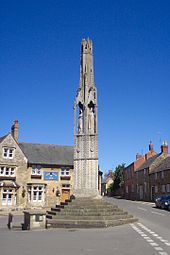Eleanor Cross
Eleanor cross ( English Eleanor cross ; Eleonorenkreuz ) is the name of a series of twelve memorial crosses that were erected in England after 1290 between Lincoln and London. The architecture of the crosses had a significant influence on the English Gothic .
Historical background
The first wife of King Edward I of England , Eleanor of Castile , died of a fever on November 28, 1290 in Harby, Nottinghamshire . Her body was first embalmed in Lincoln and then taken to Westminster Abbey in London . Edward I had a memorial cross (Eleanor cross) set up in all the places where the funeral procession spent the night.
architecture
Based on the (no longer existing) Montjoies , which were created in 1271 to mark the funeral procession for Louis the Saint from Paris to Saint-Denis , the architecture takes up motifs from French cathedral Gothic, in particular its pinnacles , eyelashes and crabs . They were designed by a group of architects who were specially selected for this. The Cross at Charing was executed by Richard Crundale; five crosses were designed by John of Battle, who already worked at Vale Royal Abbey . The Lincoln Cross was created by Richard of Stow, who soon after became the chief architect of the Lincoln Cathedral Works. The cross in Westcheap goes back to Michael of Canterbury , who later worked as court builder at Westminster Abbey .
Location of the twelve crosses
The twelve crosses were in the following locations: Lincoln , Grantham , Stamford , Geddington , Hardingstone near Northampton , Stony Stratford , Woburn , Dunstable , St Albans , Waltham Cross , Westcheap (now Cheapside in London ) and Charing (now Charing Cross ) (London ).
The preserved crosses
Only the simplest of the crosses have survived. The cross at Charing Cross is a Victorian imitation . A modern cross was erected in Dunstable.
The northernmost of the crosses was erected in St. Catherine's Convent in Lincoln; a fragment is in Lincoln Castle .
A fragment of the cross in Stamford is preserved in the Stamford Museum.
Fragments of the cross in Westcheap are kept in the Museum of London .
The crosses in Waltham, Geddington and Hardingstone are more or less completely preserved. The cross is best preserved at Geddington.
The cross at Geddington is triangular in plan in a hexagon.
In the case of the Hardingstone Cross (on the corner of Delapré Abbey , with an octagonal floor plan), the keel arch is used for the first time in England .
The Waltham Cross was restored several times and the sculptures were partially replaced by replicas in the 1950s. The originals are now in the Victoria and Albert Museum .
literature
- Günter Kowa: Architecture of the English Gothic. Dumont Buchverlag, Cologne 1990, ISBN 3-7701-1969-X , pp. 166–170.



